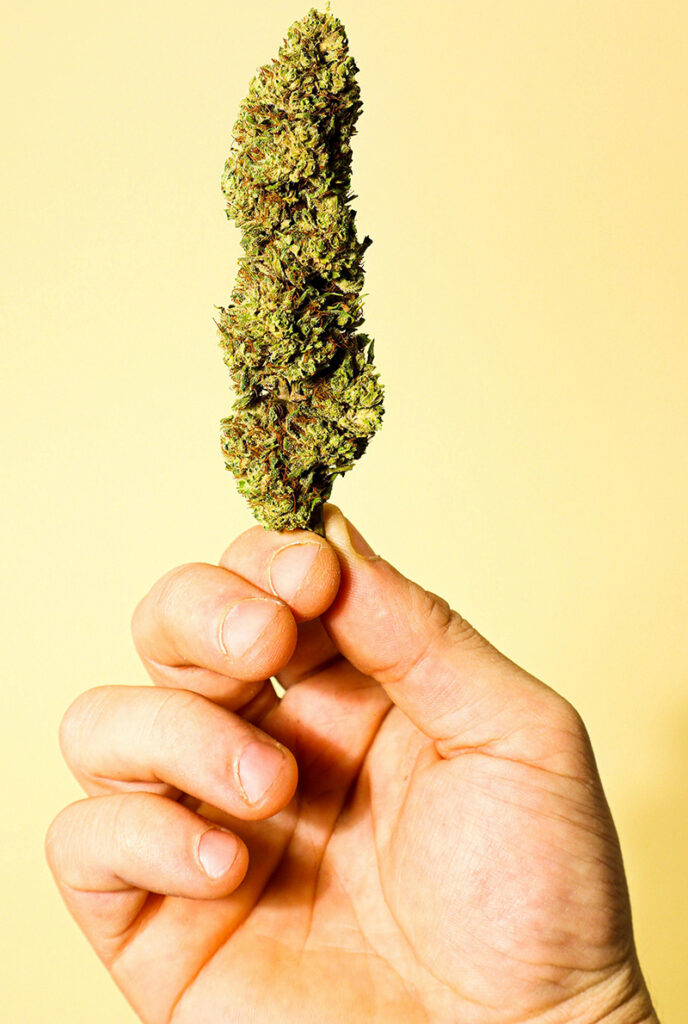Table of Contents
- 1 The Opioid Epidemic and the Need for Alternative Pain Management
- 2 How Cannabis Can Help with Chronic Pain Relief
- 3 The Anti-Inflammatory Properties of Cannabinoids
- 4 Choosing the Right Cannabis Strains and Delivery Methods for Pain
- 5 Frequently Asked Questions About Cannabis for Pain Management
- 6 So, is Cannabis the Best Way to Control Chronic Pain without Opioids?
- 7 Conclusion
Last Updated on February 21, 2024 by Team Spinfuel

You’ve probably heard that cannabis can help with pain, but is it really a viable alternative to potentially addictive and dangerous opioids? If you or someone you love suffers from chronic pain, you may have wondered about trying marijuana instead of powerful prescription meds.
This article will give you the lowdown on using cannabis to control chronic pain, including the benefits, different options to try, and what the research shows about its effectiveness. We’ll also discuss concerns like addiction risk and side effects. With opioid misuse at crisis levels, many chronic pain patients are looking for safer ways to manage their symptoms. Read on to learn if cannabis could be right for you or your loved one.
The Opioid Epidemic and the Need for Alternative Pain Management
The opioid crisis in the U.S. has made it difficult for chronic pain patients to access proper treatment. Strict restrictions and regulations on opioid prescriptions aimed at curbing addiction rates have also prevented many honest pain patients from finding relief. Cannabis offers a promising alternative for pain management without the risks of overdose and addiction associated with opioids.
The Crackdown on Opioids
In an effort to combat the opioid epidemic and rising overdose deaths, the government has cracked down on prescription painkillers. While limiting the supply of opioids aims to curb misuse, it also hurts pain patients who genuinely need them to function. Many pain patients now struggle to get the medication they require for pain control due to these restrictions.
The Benefits of Cannabis for Pain
Cannabis contains compounds known as cannabinoids that can help reduce pain and inflammation. Certain strains are bred specifically for pain relief and provide an alternative treatment without the risks of opioids. Cannabis can be consumed in several ways, including smoking, vaping, tinctures, capsules, and topical creams. This gives pain patients options to find what works best for their needs.
The Promise of Cannabinoid-Based Medications
Pharmaceutical companies are developing cannabinoid-based drugs for pain relief that provide the benefits of cannabis without the high. These could give doctors another tool for treating chronic pain and help patients who don’t wish to consume cannabis directly. However, cannabis remains illegal under federal law, slowing research on its medical potential. Rescheduling cannabis could make it easier to study as an opioid alternative and improve access for pain patients.
In summary, the opioid crisis has left many chronic pain patients with limited treatment options. Cannabis and cannabinoid-based medications show promise as safer alternatives for pain management. Easing restrictions on cannabis could benefit pain patients, especially those unable to get relief from opioids alone.
When it comes to chronic pain treatment in the midst of an opioid epidemic, cannabis deserves consideration as a potentially life-changing and even life-saving option.
How Cannabis Can Help with Chronic Pain Relief
Cannabis contains compounds called cannabinoids that can help relieve chronic pain in several ways. The two main cannabinoids are THC and CBD, both of which have analgesic and anti-inflammatory effects.
THC Provides Pain Relief
THC is the main psychoactive compound in cannabis that causes the “high” feeling. It works by binding to cannabinoid receptors in the body that are involved in pain perception and inflammation. THC can help reduce chronic pain by altering how those pain signals are processed in the brain. It may also help improve your mood and help you relax, making the pain feel more tolerable.
CBD Reduces Inflammation
CBD is non-psychoactive, meaning it won’t get you high. However, it has powerful anti-inflammatory and pain-relieving effects. CBD works by inhibiting inflammatory responses in the body and impacting how pain signals are transmitted through the nervous system. Using CBD oil, capsules, or topical creams may help reduce inflammation in the tissues surrounding nerves or the spinal cord, decreasing chronic pain.
The Entourage Effect
While THC and CBD alone can help with pain, using them together may provide even greater relief due to the “entourage effect.” This means that the compounds in cannabis work synergistically, with their effects being greater than the sum of their parts. A combination of THC, CBD, and other cannabinoids can have a broader range of effects and help target multiple pain pathways at once.
Fewer Side Effects Than Opioids
Cannabis provides a safer alternative for chronic pain than highly addictive and potentially dangerous prescription opioids. The side effects of cannabis are mild, including fatigue, dizziness, and impaired memory. Opioids, on the other hand, pose risks like addiction, overdose, nausea, and respiratory depression.
For many chronic pain patients, cannabis offers similar or better pain relief with a lower risk of side effects or addiction.
Using cannabis, especially a combination of THC and CBD, may help provide natural relief from chronic pain. Talk to your doctor about whether medical cannabis could be an option to improve your pain management and quality of life.
The Anti-Inflammatory Properties of Cannabinoids
Cannabis contains compounds called cannabinoids that can help reduce inflammation in the body. The two most well-known cannabinoids are THC and CBD. While THC is the compound that produces the “high” effect, CBD is non-psychoactive and has strong anti-inflammatory properties.
CBD Reduces Inflammation
CBD works with your body’s endocannabinoid system to help regulate various functions, including your immune response. CBD can help reduce inflammation in several ways. It prevents the production and release of pro-inflammatory cytokines, which are proteins that signal the immune system to become active. CBD also inhibits the production of inflammatory macrophages and neutrophils, two types of immune cells.
THC Also Has Anti-Inflammatory Effects
In addition to CBD, THC also exhibits anti-inflammatory effects, though through different mechanisms. THC activates CB2 receptors found throughout the body, including in the immune system. By activating these receptors, THC can reduce the inflammatory response.
THC also inhibits the production of cytokine and chemokine inflammatory messengers. Together, the anti-inflammatory effects of CBD and THC may help reduce inflammation, ease pain, and provide comfort for those suffering from chronic pain.
Cannabis May Replace Opioids
For some patients, cannabis can be used as an alternative or adjunct treatment to opioids for chronic pain. Opioids are highly addictive and often come with side effects like nausea, constipation, and dizziness. Cannabis is less addictive and does not pose the same risk of overdose as opioids.
Many patients are able to reduce or eliminate opioid use by incorporating cannabis into their pain management regimen under the guidance of a doctor.
Using cannabis to control chronic pain and inflammation is still a new area of research, but early results are promising. By harnessing the anti-inflammatory power of compounds like CBD and THC, cannabis could provide a safer alternative for those dealing with long-term pain. Always talk to your doctor before making any changes to your treatment plan.
Choosing the Right Cannabis Strains and Delivery Methods for Pain
When using cannabis to manage chronic pain, choosing the right strain and delivery method is key to getting the relief you need. ### Strains Certain cannabis strains are better for pain relief than others.
Look for indica-dominant hybrids or full indica strains, which tend to have higher amounts of CBD and other pain-relieving cannabinoids. Some highly effective options include:
- ACDC: A sativa-dominant strain high in CBD. It relieves inflammation and dulls pain without an intense psychoactive effect.
- Harlequin: An indica-dominant strain with a 5:2 CBD to THC ratio. It reduces pain and inflammation with minimal euphoria.
- Blueberry Headband: An indica-dominant hybrid with 15-20% THC. It alleviates pain, relaxes muscles, and lifts mood.
You may need to try a few different strains to find the one that works best for your pain. Keep a journal to track effects and find your ideal cannabinoid profile.
Delivery Methods

How you consume cannabis also impacts its pain-relieving effects. Inhaled methods like vaping and smoking work quickly but effects fade faster. Edibles and tinctures have longer-lasting relief but take longer to kick in and can be difficult to dose. Topicals applied directly to the skin offer targeted relief with no psychoactivity.
For chronic pain, a combination of delivery methods often works well. You might vape or smoke for quick relief of severe pain, use edibles or tinctures for all-day coverage, and apply a topical cream to sore areas.
The key is starting low and going slow with any method until you find the right balance of relief and side effects.
Using cannabis for pain is a learning process. But with some patience and experimentation, you can find a personalized pain management plan without the risks of opioids. The rewards of natural relief and improved quality of life make the effort worthwhile.
Frequently Asked Questions About Cannabis for Pain Management
How does cannabis help with chronic pain?
Cannabis contains compounds called cannabinoids, including THC and CBD, that interact with your body’s endocannabinoid system. This system regulates things like pain, inflammation, and stress. Cannabinoids can help relieve chronic pain in a few ways:
- They reduce inflammation in the body and joints. Chronic pain is often linked to inflammation, so reducing inflammation can help ease discomfort.
- They relax muscles. Cannabinoids release tension in muscles and soft tissues in the body. This can relieve pain from conditions like fibromyalgia or injuries.
- They alter pain perception. Cannabinoids change the way your brain perceives signals from pain receptors, making pain feel less intense. They can also improve your mood, helping you feel less bothered by chronic pain.
- They help you sleep. Getting good sleep is important for managing chronic pain. Cannabinoids can help relax your body and mind, making it easier to fall asleep and stay asleep. Improved sleep can then help lessen your pain levels during the day.
How do I find the right cannabis product and dosage for my pain?
With many options available, from CBD oil to THC gummies, it can take some experimenting to find what works best for you. Some tips:
- Start with a low dose of CBD, around 5 to 10 milligrams. Slowly increase the dose every few days until you notice pain relief. CBD produces no high and is very safe, so you can afford to start low and go slow.
- Consider a 1:1 CBD to THC ratio. This provides pain relief benefits from both cannabinoids while minimizing the psychoactive effects of THC. A dose of 2.5 to 10 milligrams of each cannabinoid is a good place to start.
- Look for full-spectrum or broad-spectrum products. These provide a range of cannabinoids, terpenes, and other cannabis compounds that work together for greater pain relief. Isolate CBD lacks these additional benefits.
- Track your symptoms and doses to determine the most effective regimen for you. It can take weeks or months of experimenting to pinpoint what works best for relieving your chronic pain. Patience and consistency are key.
- Talk to your doctor, especially if you take any other medications. Cannabis can potentially interact with some medications, so you want to make sure there are no contraindications for your situation. Your doctor may even be able to help guide your dosing and product selection.
So, is Cannabis the Best Way to Control Chronic Pain without Opioids?
 Chronic pain sufferers are increasingly turning to cannabis as an alternative to opioids. Cannabis contains compounds called cannabinoids, including CBD and THC, that can help relieve pain and reduce inflammation.
Chronic pain sufferers are increasingly turning to cannabis as an alternative to opioids. Cannabis contains compounds called cannabinoids, including CBD and THC, that can help relieve pain and reduce inflammation.
Many people find that cannabis effectively manages their pain without the risks of addiction and overdose that come with opioids.
Cannabis provides pain relief in several ways. THC acts on the cannabinoid receptors in the brain and body to reduce the perception of pain and acts as an anti-inflammatory.
CBD also has anti-inflammatory effects and may boost the body’s own endocannabinoid system to help regulate pain and mood. Cannabis can provide full-body relaxation to unwind tense, painful muscles.
The method of consumption affects how quickly and intensely the effects are felt. Inhaling cannabis by smoking or vaping provides the fastest relief from chronic pain, while edibles, capsules, and tinctures have longer-lasting effects.
You can tailor the THC to CBD ratio to your needs and tolerance level. Many find a 1:1 ratio of THC to CBD provides analgesia along with the benefits of CBD without an intense high.
Of course, cannabis will not eliminate pain for everyone or in all cases. It may take time to find the optimal strain, potency, and method of delivery for your pain. Cannabis can cause side effects like fatigue, dizziness, and impaired memory.
It may not be a viable option if you have a job or responsibilities where intoxication could be an issue. However, when compared to the risks of long-term opioid use, cannabis can absolutely be worth trying as a natural way to find relief from chronic pain. By starting low, going slow, and adjusting dosage as needed, cannabis could transform how you manage pain and improve your quality of life.
Conclusion
So, if you’re living with chronic pain, cannabis might be something to investigate. Talk to your doctor about whether it could be a good option for you. There are different ways to take it – smoking, vaping, oils, edibles – so you can find what works best for your situation.
Just remember to start low and slow with the dosing until you know how it affects you. The research shows it’s much less risky than opioids. And it could give you some relief, help you relax and sleep better, and improve your overall quality of life. Give it a try if it’s accessible where you live.
At the very least, it’s worth a conversation with your healthcare provider to see if medical marijuana is worth exploring to manage your chronic pain.
Read More about Pain and Cannabis in Spinfuel:
Powerful Cannabis Strains and Inflammation Relief for 2024
The Cannabis Business – 4 Tips to Help You Grow and Expand
Why Should You Get Into Hybrid Strains?
Weed in Wonderland: Unlocking the Benefits of Cannabis for Restful Sleep








